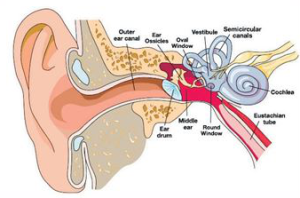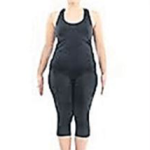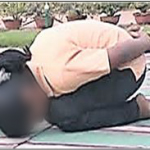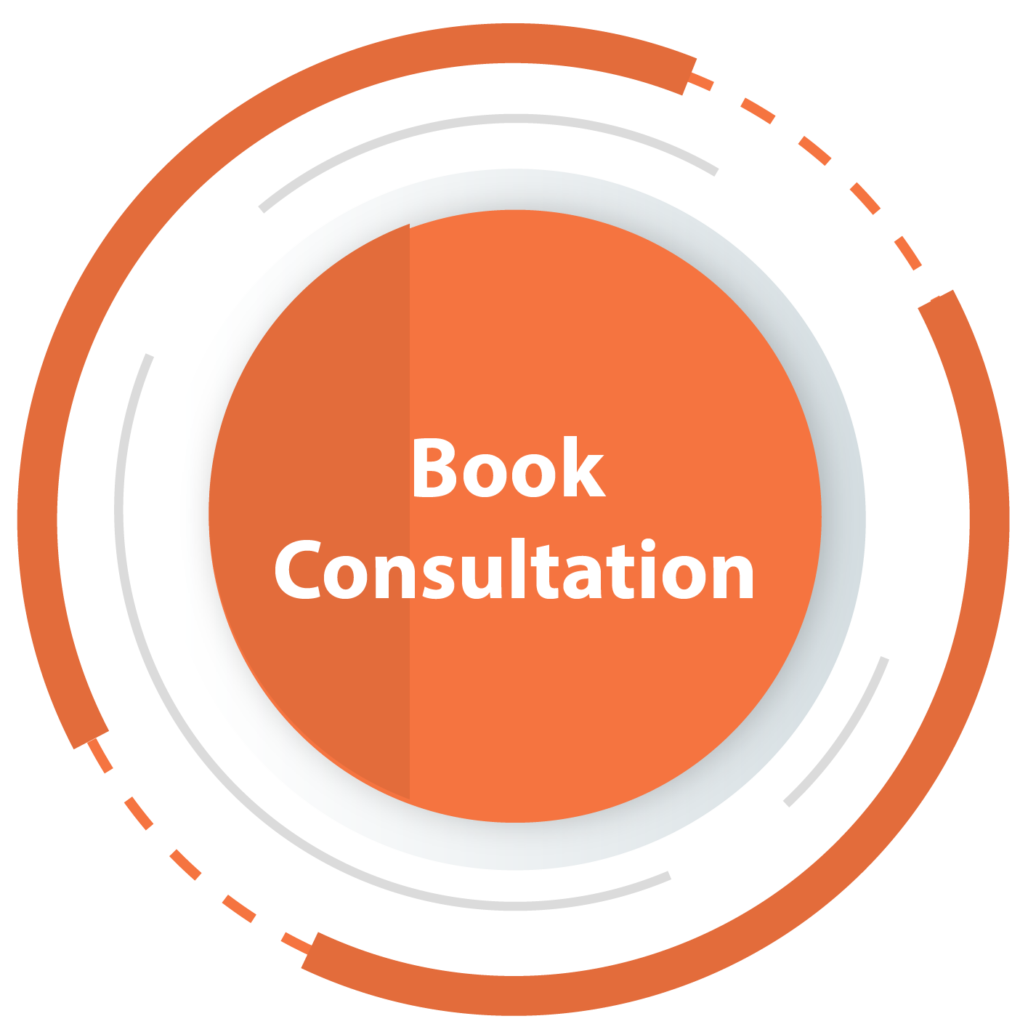Ears
The ear an organ of hearing and balance, consisting of a cavity in the skull structure lined with soft tissue, which encloses three distinctive spaces filled with air or liquid (external, middle and inner ear). These distinctive spaces host both sound transmission mechanisms and sensory apparatuses.
The external or outer ear, consists of:
- Pinna or auricle
- External auditory canal or tube that connects the outer ear to the inside or middle ear.
- Tympanic membrane (also called the eardrum) which divides the external ear from the middle ear.
Middle ear (tympanic cavity), consists of:
- Ossicles which are 3 small bones that are connected and transmit the sound waves to the innerear. These bones are called: Malleus, Incus and Stapes.
- Eustachian tube / canal that links the middle ear with the back of the nose. It helps to equalize the pressure in the middle ear which is needed for the proper transfer of sound waves. The eustachian tube is lined with mucous, just like the inside of the nose and throat.
Inner ear, consists of:
- Cochlea (contains the nerves for hearing).
- Vestibule (contains receptors for balance).
- Semicircular canals (contain receptors for balance).
Hearing
Hearing starts with the outer ear. When a sound is made outside the outer ear, the sound waves or vibrations travel down the external auditory canal and strike the eardrum (tympanic membrane). The eardrum vibrates and the vibrations are then passed to 3 tiny bones in the middle ear called the ossicles. The ossicles amplify the sound and send the sound waves to the inner ear and into the fluid-filled hearing organ (cochlea).
Once the sound waves reach the inner ear, they are converted into electrical impulses, which the auditory nerve sends to the brain. The brain then translates these electrical impulses as sound.
Ear diseases can be worrying because they could lead to pain and discomfort or even serious hearing impairment. There are diseases, infections and cancers that affect specific parts of the ear and can lead to hearing loss. Hearing loss can happen for many reasons. One can either be born with hearing loss while others may lose their hearing slowly over time.
- Boils
- Swimmer’s Ear
- Meniere’s Disease
- Otomycosis
- Tinnitus
- Ear Infection
- Vestibular Neuritis
Ear Detox
Tinnitus
Complementory Therapy
Eustachian Meditation – 8 Steps
Step 1 – Chanting
- Stand in Tadasana, feet and knees close together
- Hands along the thighs, with fingers stretched out.
- Legs, trunk and head aligned in a straight line.
- Eyes closed and relax the whole body.
- Start the following chant “Karmanyevadhkiraste ma phalesu Kadachana Ma Karma Phala heturbhuh karmanih”.
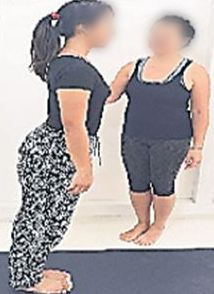
Step 2 – Centering by feet
- Lean forward and feel the weight of the entire body on the toes; and then slowly return to center
- Lean backward and feel the weight of the entire body on the heels; and then slowly return to center.
- Lean to the right and feel the weight of the entire body on the right edge of the right foot; and then slowly return to center.
- Lean to the left and feel the weight of the entire body on the left edge of the left foot; and then slowly return to center.
** All movements have to be slow. The weight of the body is equally distributed throughout the soles of the feet.
Step 3 – Centering by Chanting A-kara, U-kara and M-kara
- Lean forward, chanting A-kara and feel the weight of the entire body on the toes; and then slowly return to center
- Lean backward, chanting U-kara and feel the weight of the entire body on the heels; and then slowly return to center.
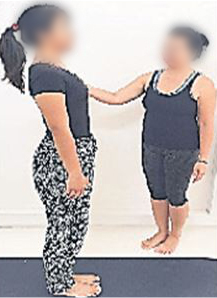
- Lean to the right, chanting M-kara and feel the weight of the entire body on the right edge of the right foot; and then slowly return to center.
- Lean to the left, chanting M-kara and feel the weight of the entire body on the left edge of the left foot; and then slowly return to center.
** All movements have to be slow
Step 4 – Centering by Chanting OM
- Lean forward, chanting OM and feel the weight of the entire body on the toes; and then slowly return to center.
- Lean backward, chanting OM and feel the weight of the entire body on the heels; and then slowly return to center.
- Lean to the right, chanting OM and feel the weight of the entire body on the right edge of the right foot; and then slowly return to center.
- Lean to the left, chanting OM and feel the weight of the entire body on the left edge of the left footand then slowly return to center.
** All movements have to be slow
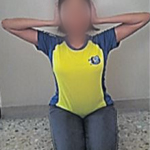
Step 5 – Maintaining pressure in Eustachian Canal (Sitting in Vajrasana) With both hands covering over the ears
- Press your hands on the ears and release the pressure * Practice for 5 rounds of 5 times
- Press your hands on the ears and chant Bhramari * Practice for 5 rounds of 5 times
- Press your hands on the ears and chant OM * Practice for 5 rounds of 5 times
** All movements have to be slow
Step 6 – Balancing pressure from Head to Spine (Sit in Vajrasana or Sukhasana)
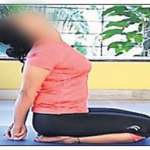
- Bring the hands behind your back, make a fist of the right hand and hold the right wrist with the left hand; relax the shoulders.
- While inhaling, bend backwards from the waist and opening up the chest.
- Hile exhaling slowly, chant OM and bend forward from the waist bringing the forehead on to the ground in front of the knees.
- Then inhaling slowly come up to the vertical position * Practice for 5 rounds.
Step 7 – Make Resolve
- Dwell in total silence.
- Resolve with positive thoughts (9 times).Eg. I’m positive, I’m healthy, I’m happy, I’m grateful, etc.
Step 8 – Ending Prayer
- Om Shantih, Shantih, Santhihih….
Subtle Point
- Do not hyper extend the neck during therapy.
- Pressure on the hear should be moderate and slow practice of procedure.
Indication
- Reduction of stress; Vertigo; Ear issues; Tinnitus; Trigeminal nerve issue.
Contraindication
- Mental Issues patient; Infected ear.
Acknowledgement to:
- CYT / ATTC Students of Union Yoga Ayurveda Singapore
- Swami Vivekananda Yoga Prakashana Trust, Bangalore
Disclaimer
Yoga Ayurveda Therapy is Complementary Medicine and doesn't alternates any conventional treatment.
Yoga-Ayurveda Therapy needs physical assistance which may need physical touch. You can ask teacher or therapist not to give physical touch or assistance and based on whatever you choose, our teacher or therapist will follow the instructions. Any point you want to change the preference, then please inform teacher or therapist and management in writing. You will take responsibility of your decision and will not hold Union Yoga Ayurveda responsible for any kind of damage.
All kind of Yoga Ayurveda teaching and therapy can cause certain injuries and you are accepting those injuries. Signing up for the therapy or yoga courses means that you are aware of the probable injuries.
Union Yoga Ayurveda (Union Centre Pte Ltd) and its staff are not liable or responsible for any injuries caused during the session which are visible or not visible, physical or hormonal or mental. You as client take full responsibility of your own decision and will not claim any kind of compensation in terms of money or any resources for the damage caused because of due process.
Related Topics
- Yoga Therapy & Common Ailments
- Diabetes Mellitus
- Yoga & Glaucoma
- Chronic Myeloid Leukemia
- Gastro-Esophageal Reflux / Gastritis
- High Blood Pressure
- For Anxiety neurosis, Depressions etc
- For Neurological issues
- Cataract and short / long Sightedness
- Scoliosis / Herneated disc / Sciatica
- Menstrual Issues

